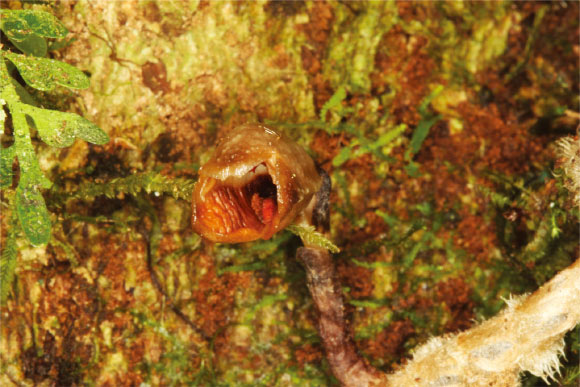Dr. Johan Hermans, a botanist specializing in orchids and an honorary research associate of the Royal Botanic Gardens, Kew, has discovered a new species of the orchid genus Gastrodia in humid evergreen forests in southeast Madagascar.

The flower of Gastrodia agnicellus, showing the stem and part of the rhizome. Image credit: Rick Burian.
Established by Robert Brown in 1810, Gastrodia is a genus of terrestrial leafless orchids in the family Orchidaceae.
Commonly known as potato orchids, it includes over 90 species found in the Old World tropics, mostly in Australasia across to the Pacific islands, but with several species in tropical Africa and Madagascar, and one endemic in the Mascarenes.
During their life cycle, the potato orchids remain underground most of the time, emerging only to flower or sometimes just to set fruit.
The name refers to the belly-like appearance of the floral tube and mentum in some of the Gastrodia species.
Dr. Hermans first noticed the new potato orchid species, Gastrodia agnicellus, during a field trip to Madagascar in December 2017.
“During a more recent trip, in September 2019, the same site was re-visited and after extensive searching, a few new developing fruiting inflorescences were found,” he said.
“It was not until a layer of leaf litter was lifted that a small number of flowers were also discovered.”
“The flowers had a noticeable musk rose-like scent that became stronger as temperature increased.”
“Several ants were noticed entering the flowers but these were likely to be nectar thieves.”

Gastrodia agnicellus: (a) l/s flower, (b) habit and flower, face view, (c) fruit and t/s fruit, (d) column, (e) corolla opened and lip, (f) fruit, short stem and long stem, (g) lip & lip side view, (h) column, and column side view, (i) anther cap, (j) seed, side view and face view. Image credit: Deborah Lambkin.
Gastrodia agnicellus is known only from the Vatovavy-Fitovinany region of Madagascar’s Fianarantsoa province.
“Most people think of orchids as showy, vibrant and beautiful, but Gastrodia agnicellus is quite the opposite,” the researcher said.
“The 1.1-cm flowers of this orchid are small and brown.”
“After Gastrodia agnicellus is pollinated, the stalks grow, holding the fruits well above the forest floor so that the dust-like seeds can better disperse.”
“The orchid depends on fungi for nutrition and has no leaves or any other photosynthetic tissue.”
Dr. Hermans reported the discovery of Gastrodia agnicellus in a paper in Curtis’s Botanical Magazine.
_____
Johan Hermans. 2020. Gastrodia agnicellus: a new holomycotrophic orchid from southeast Madagascar Orchidaceae. Curtis’s Botanical Magazine 37 (3): 385-395; doi: 10.1111/curt.12354







